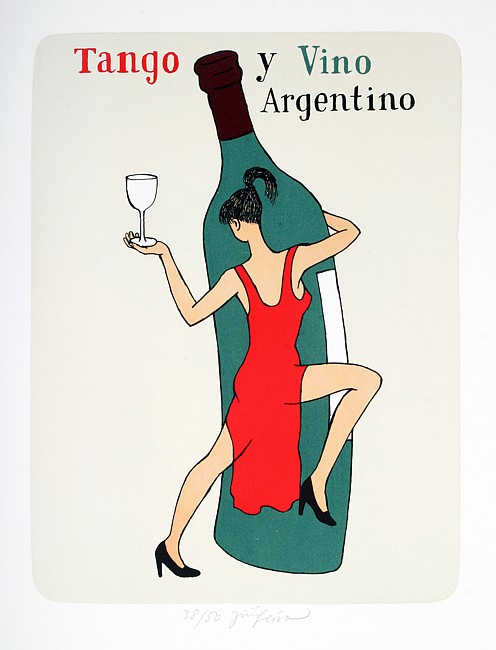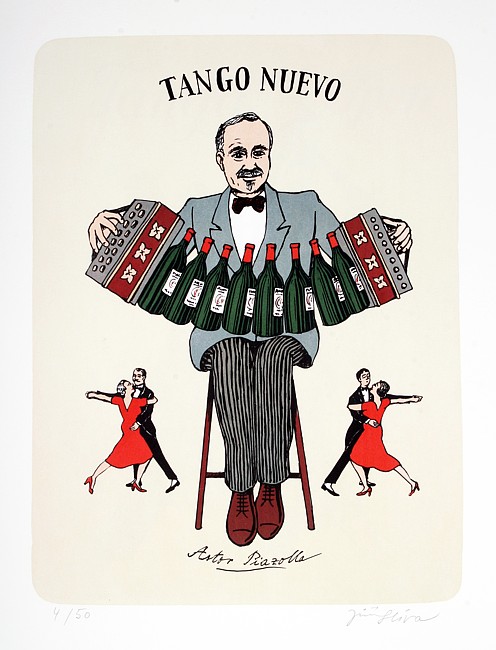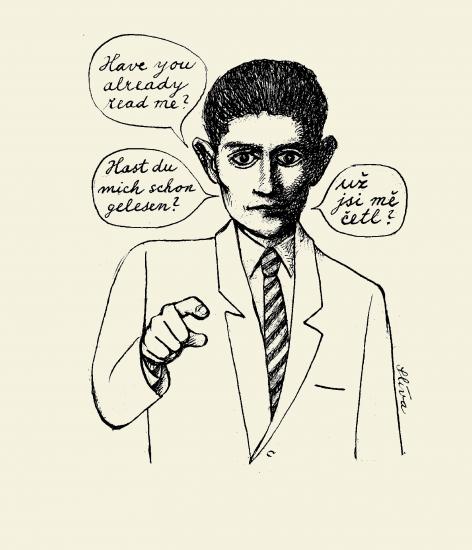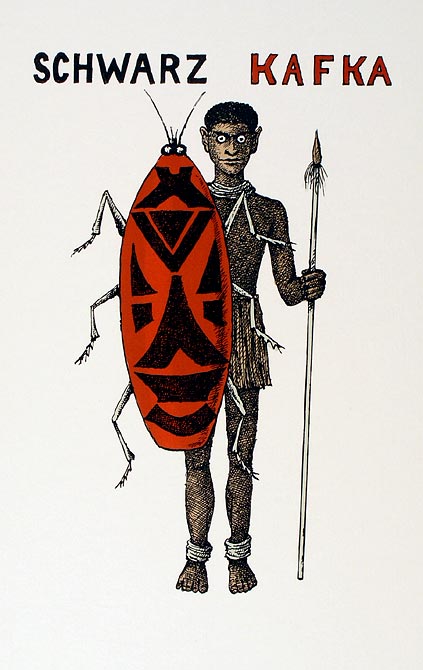“Please — consider me a dream.”
Franz Kafka
 Illustration by Jiří Slíva
Illustration by Jiří Slíva
A Dream is a short story by Franz Kafka. In the short piece, the narrator describes a dream, where Joseph K. is walking through a cemetery. There are tombstones around him, and the setting is the typical misty and dim atmosphere. Soon he sees someone carving out a name on a stone, and as he approaches he soon notices it is his own name.
Kafka was known to be enthralled by psychoanalytic theory primarily due to his fascination with dreams. As we already know, one of his most famous stories, The Metamorphosis, starts with the main character waking from a dream. He felt there was great power, both creatively and emotionally, with dreams. The story is also an example of the theme of mortality, lack of power among the living, and the struggle to stay alive while aware of one’s impending death.
“Josef K. was dreaming:It was a beautiful day and K. wanted to go on a walk. But no sooner had he taken a few steps than he was already at the graveyard.Its paths were highly artificial, impractical in their windings, yet he glided along such a path as if hovering unshakably over raging water. From far away, he spotted a freshly dug burial mound at which he wanted to halt. This burial mound exerted an almost enticing effect on him, and he felt he could not get there fast enough. At times, however, he could barely glimpse the mound, it was covered with flags that twisted and flapped powerfully against one another; the flag bearers could not be seen,but there appeared to be great rejoicing.While his eyes were still riveted in the distance, he abruptly saw the burial mound next to the path – indeed almost behind him by now. He hastily leaped into the grass. Since the path continued rushing along beneath his feet as he leaped off, he staggered and fell to his knees right in front of the mound. Two men were standing behind the grave,holding a headstone between them in the air; the moment K. showed up, they thrust the stone into the earth, and it stood there as if cemented to the ground. Instantly,a third man emerged from the bushes, and K. promptly identified him as an artist. He was wearing only trousers and a misbuttoned shirt; a velvet cap was on his head; in his hand, he clutched an ordinary pencil, drawing figures in the air even as he approached.He now applied this pencil to the top end of the stone;the stone was very high, he did not even have to lean down, but he did have to bend forward,since he did not wish to step on the burial mound, which separated him from the stone. So he stood on tiptoe, steadying himself by propping his left hand against the surface of the stone. Through some extremely skillful manipulation, he succeeded in producing gold letters with that ordinary pencil; he wrote: “Here LIES—” Each letter came out clean and beautiful,deeply incised and in purest gold. After writing words, he looked back at K.; K., who was very eager to see what would come next in the inscription, gazed at the stone, paying little heed to the man. And in fact, the man was about to continue writing, but he could not, something was hindering him, he lowered the pencil and turned to K.again. This time,K. looked back at the artist, who, he noticed, was very embarrassed but unable to indicate the reason for his embarrassment. All his earlier liveliness had vanished. As a result, K. likewise felt embarrassed; they exchanged helpless glances; there was some kind of misunderstanding between them, which neither of them could clear up. To make matters worse, a small chime began tinkling inopportunely from the tomb chapel,but the artist waved his raised hand wildly, and the chime stopped.After a brief pause,it started in again; this time very softly and then promptly breaking off with no special admonition from him; it was as if it merely wanted to test its own sound. K. was inconsolable about the artist’s dilemma, he began to cry, sobbing into his cupped hands for a long time. The artist waited for K. to calm down, and then, finding no other solution, he decided to keep writing all the same. His first small stroke was a deliverance for K., but the artist obviously managed to execute it only with utmost reluctance;moreover, the penmanship was not as lovely — above all,it seemed to lack gold, the stroke moved along pale and unsteady, only the letter became very large. It was a J, it was almost completed; but now the artist furiously stamped one foot into the burial mound, making the dark soil fly up all around. At last, K. understood him; there was no time left to apologize;with all his fingers he dug into the earth, which offered scant resistance;everything seemed prepared; a thin crust of earth had been set up purely for show; right beneath it a huge hole with sheer sides gaped open, and K.,flipped over on his back by a gently current, sank into the hole. But while, with his head still erect on his neck, he was welcomed down below by the impenetrable depth, his name, with tremendous embellishments, rushed across the stone up above.Enraptured by this sight, he woke up.”
 Metamorfosis de mi ángel guardian (Metamorphosis of My Guardian Angel), by Cheiro (my former pseudonym or “incarnation”), 1998. This mixed media drawing, made in one night (while I was drinking a bottle of Chilean wine) was inspired by Franz Kafka’s The Metamorphosis, Salvador Dalí and Dürer
Metamorfosis de mi ángel guardian (Metamorphosis of My Guardian Angel), by Cheiro (my former pseudonym or “incarnation”), 1998. This mixed media drawing, made in one night (while I was drinking a bottle of Chilean wine) was inspired by Franz Kafka’s The Metamorphosis, Salvador Dalí and Dürer Wing of a Blue Roller, Albretch Dürer, 1512
Wing of a Blue Roller, Albretch Dürer, 1512 The Metamorphosis of Narcissus, Salvador Dalí, c.1937
The Metamorphosis of Narcissus, Salvador Dalí, c.1937






















































